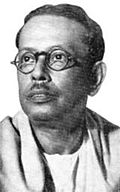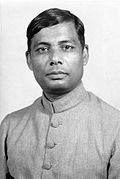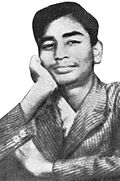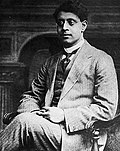| Poet | Image | Pen Name | Era | Work |
|---|
| Iswarchandra Gupta |  | | 1812–1859 CE | Known for satire and revival of medieval style in Bengali poetry. |
| Michael Madhusudan Dutta |  | | 1824–1873 CE | Introduced blank verse in Bengali poetry; author of Meghnad Badh Kavya. |
| Nabinchandra Sen |  | | 1847–1909 CE | Historical epics like Palashir Juddha and Raivatak. |
| Kazem Ali Quereshi |  | Kaykobad | 1857–1951 CE | Wrote Mahashmashan; noted for Islamic and nationalistic themes. |
| Girindramohini Dasi | | | 1858–1924 CE | One of the first notable female Bengali poets. |
| Akshay Kumar Baral |  | | 1860–1919 CE | Known for romantic and devotional poetry. |
| Rabindranath Tagore |  | Gurudev, Kabiguru, and Biswakabi | 1861–1941 CE | Bengali polymath—Poet, Novelist, Playwright, Short-story writer, Music composer, Essayist, Philosopher, Literary critic, Social reformer, Politician, Painter. First non-European to win the Nobel Prize in Literature (1913). |
| Dwijendralal Ray |  | | 1863–1913 CE | Known for patriotic songs and plays like Mewar Patan. |
| Jatindramohan Bagchi | | | 1878–1948 CE | Lyric poet known for his emotional tone and simplicity. |
| Satyendranath Dutta |  | | 1882–1922 CE | Known as the "wizard of rhyme"; focused on classical themes and metres. |
| Jatindranath Sengupta |  | | 1887–1954 CE | Satirical and humanist poet; part of modernist movement. |
| Mohitlal Majumdar |  | | 1888–1952 CE | Romantic and philosophical poet; literary critic too. |
| Kazi Nazrul Islam |  | | 1899–1976 CE | Bidrohi Kobi; wrote revolutionary poetry like Bidrohi, patriotic and Islamic songs. |
| Jibanananda Das |  | | 1899–1954 CE | Pioneer of modernism; famous for Banalata Sen and Ruposhi Bangla. |
| Amiya Chakravarty | | | 1901–1986 CE | Poet, scholar, and companion of Tagore; known for philosophical depth. |
| Sudhindranath Dutta | | | 1901–1960 CE | Modernist poet; known for intellectual and complex verse. |
| Jasimuddin |  | | 1903–1976 CE | Polli Kobi; author of pastoral poems like Nakshi Kanthar Math. |
| Buddhadeva Bose |  | | 1908–1974 CE | Key figure in modern Bengali literature; editor of Kavita. |
| Bishnu Dey | | | 1909–1982 CE | Modernist and Marxist poet; known for combining art and ideology. |
| Ahsan Habib | | | 1917–1985 CE | Known for humorous and lyrical poems in post-Tagore era. |
| Farrukh Ahmad | | | 1918–1974 CE | Islamic and anti-colonial themes; called Saimum Kobi. |
| Syed Ali Ahsan | | | 1922–2002 CE | Poet, critic, and academic; translated Bengali literature into English. |
| Sukanta Bhattacharya |  | | 1926–1947 CE | Socialist poet; known for poems like Chharpatra written during youth. |
| Shamsur Rahman |  | | 1929–2006 CE | Major modern poet of Bangladesh; explored urban life, politics, love. |
| Al Mahmud |  | | 1936–2019 CE | Blended romanticism and rural life; known for Sonali Kabin. |
| Abul Hasan | | | 1947–1975 CE | Lyrical and melancholic poetry; noted for early death and deep emotion. |
| Rudra Mohammad Shahidullah |  | | 1956–1991 CE | Revolutionary and romantic poet; known for intense emotional expression. |









































